Complete Solutions to ADDITIONAL QUESTIONS AND ANSWERS of chapter HOW DO ORGANISMS REPRODUCE? of Class 10 book with complete answers and questions
| Class 10 | BIOLOGY |
| Chapter | HOW DO ORGANISMS REPRODUCE? |
| KUMAR PRAKASHAN | ADDITIONAL QUESTIONS AND ANSWERS |
| Number Of Questions | 28 |
| Academic Year | 2023-24 |
Distinguish between:
Asexual reproduction and Sexual reproduction03:36View SolutionDistinguish between:
Asexual reproduction and Sexual reproduction03:36View SolutionDistinguish between:
Binary fission and Multiple fission03:58View SolutionDistinguish between:
Budding and Sporulation05:21View SolutionDistinguish between:
Puberty stage in male and Puberty stage in female03:48View SolutionDistinguish between:
Male reproductive system and Female reproductive system06:56View SolutionDistinguish between:
Contraceptive mechanical method and Contraceptive chemical method02:35View SolutionGive scientific reasons for the following statements:
The offsprings formed through asexual reproduction have same genetic constitution as their parent cell.03:05View SolutionGive scientific reasons for the following statements:
Variation is necessary for the maintenance of existence of any species.03:15View SolutionGive scientific reasons for the following statements:
Testes are situated outside the abdominal cavity.02:12View SolutionGive scientific reasons for the following statements:
The number of bryophyllum keep on increasing in garden.02:14View SolutionGive scientific reasons for the following statements:
The property of vegetative propagation is useful in agricultural purposes.03:43View SolutionGive scientific reasons for the following statements:
Extinction of species can be prevented in sexually reproducting organisms.04:53View SolutionGive scientific reasons for the following statements:
Contraceptive pills are helpful to prevent pregnancy.02:21View SolutionGive scientific reasons for the following statements:
The use of ultrasound technique should be banned for the sex determination.02:48View SolutionGive scientific reasons for the following statements:
Prenatal determination sex has been prohibited by law.03:11View SolutionGive scientific reasons for the following statements:
Each new generation through sexual mode of reproduction will end up in equal number of chromosomes and the DNA content instead of double to its parents.04:18View SolutionCarefully observe the given diagram and answer the questions related with it:
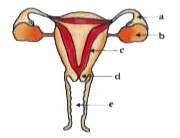
Write name of a, b, c, d and e in given diagram.01:50View SolutionCarefully observe the given diagram and answer the questions related with it:
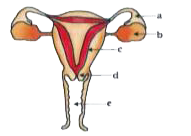
Where do given events occur?
(i) Formation of ovum and its release
(ii) Fertilisation
(iii) Implantation of fertilised ovum02:33View SolutionCarefully observe the given diagram and answer the questions related with it:
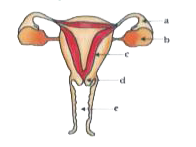
The inner wall of uterus ………….....
(i) Before ovulation and
(ii) What happens if ovum does not get fertilised ?05:45View SolutionCarefully observe the given diagram and answer the questions related with it:
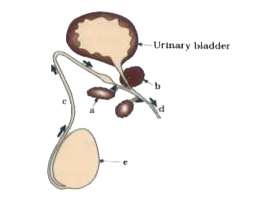
Do labelling of a, b, c, d and e in given diagram.03:05View SolutionCarefully observe the given diagram and answer the questions related with it:
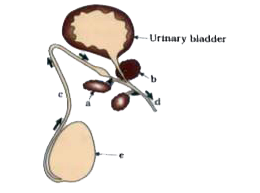
Where do the given events occur?View SolutionCarefully observe the given diagram and answer the questions related with it:
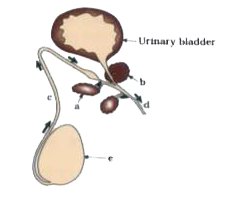
Both sperms and urine pass.
( ii) Sperms delivered through in it.
(iii) Add their fluid secretion with sperms.06:43View SolutionCarefully observe the given diagram and answer the questions related with it:
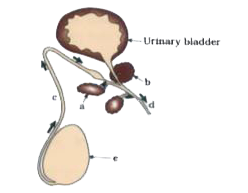
'd' part passes through which organ ? What changes are noticed in such organ during adolescence ?04:14View SolutionCarefully observe the given diagram and answer the questions related with it:
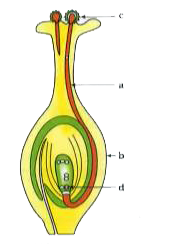
Identify 'a' and state what it carries.03:16View SolutionCarefully observe the given diagram and answer the questions related with it:
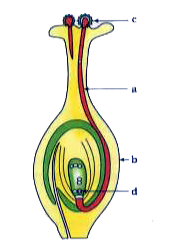
Identify 'b' and state the changes in its structure after fertilisation.01:24View SolutionCarefully observe the given diagram and answer the questions related with it:
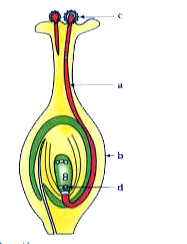
Identify 'c' and mention from where is it released and by which process does it reach here.03:26View SolutionCarefully observe the given diagram and answer the questions related with it:
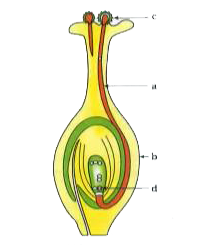
Identify 'd' and state how seeds are formed ?03:05View Solution
ADDITIONAL QUESTIONS AND ANSWERS questions and complete solutions for chapter HOW DO ORGANISMS REPRODUCE? of KUMAR PRAKASHAN of Class 10
All Exercises from KUMAR PRAKASHAN Class 10 BIOLOGY HOW DO ORGANISMS REPRODUCE?
- ADDITIONAL QUESTIONS AND ANSWERS
- OBJECTIVE QUESTIONS AND ANSWERS
- OBJECTIVE QUESTIONS AND ANSWERS (Answer as directed : (Miscellaneous))
- OBJECTIVE QUESTIONS AND ANSWERS (Answer the following questions in short : )
- OBJECTIVE QUESTIONS AND ANSWERS (Define: OR Explain the terms: )
- OBJECTIVE QUESTIONS AND ANSWERS (Diagram based questions: )
- OBJECTIVE QUESTIONS AND ANSWERS (Fill in the blanks : )
- OBJECTIVE QUESTIONS AND ANSWERS (Select the correct option from those given below each question : )
- OBJECTIVE QUESTIONS AND ANSWERS (State whether the following statements are true or false: )
- PRACTICAL SKILL BASED QUESTIONS WITH ANSWERS
- QUESTIONS AND ANSWERS
- TEXTUAL EXERCISE
- VALUE BASED QUESTIONS WITH ANSWERS
